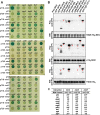Quantitative Proteomics Analysis Reveals the Min System of Escherichia coli Modulates Reversible Protein Association with the Inner Membrane
- PMID: 26889046
- PMCID: PMC4858940
- DOI: 10.1074/mcp.M115.053603
Quantitative Proteomics Analysis Reveals the Min System of Escherichia coli Modulates Reversible Protein Association with the Inner Membrane
Abstract
The Min system of Escherichia coli mediates placement of the division septum at the midcell. It oscillates from pole to pole to establish a concentration gradient of the division inhibition that is high at the poles but low at the midcell; the cell middle thereby becomes the most favorable site for division. Although Min oscillation is well studied from molecular and biophysical perspectives, it is still an enigma as to whether such a continuous, energy-consuming, and organized movement of the Min proteins would affect cellular processes other than the division site selection. To tackle this question, we compared the inner membrane proteome of the wild-type and Δmin strains using a quantitative approach. Forty proteins that showed differential abundance on the inner membrane of the mutant cells were identified and defined as proteins of interest (POIs). More than half of the POIs were peripheral membrane proteins, suggesting that the Min system affects mainly reversible protein association with the inner membrane. In addition, 6 out of 10 selected POIs directly interacted with at least one of the Min proteins, confirming the correlation between POIs and the Min system.Further analysis revealed a functional relationship between metabolism and the Min system. Metabolic enzymes accounted for 45% of the POIs, and there was a change of metabolites in the related reactions. We hypothesize that the Min system could alter the membrane location of proteins to modulate their enzymatic activity. Thus, the metabolic modulation in the Δmin mutant is likely an adaptive phenotype in cells of abnormal size and chromosome number due to an imbalanced abundance of proteins on the inner membrane. Taken together, the current work reports novel interactions of the Min system and reveals a global physiological impact of the Min system in addition to the division site placement.
© 2016 by The American Society for Biochemistry and Molecular Biology, Inc.
Figures





References
-
- de Boer P. A., Crossley R. E., and Rothfield L. I. (1989) A division inhibitor and a topological specificity factor coded for by the minicell locus determine proper placement of the division septum in E. coli. Cell 56, 641–649 - PubMed
MeSH terms
Substances
LinkOut - more resources
Full Text Sources
Other Literature Sources
Molecular Biology Databases
Miscellaneous

